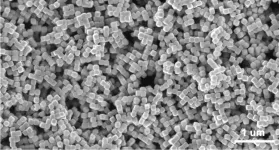Research finds increased first-trimester exercise may reduce gestational diabetes risk
2021-01-11
(Press-News.org) Pregnant women who exercise more during the first trimester of pregnancy may have a lower risk of developing gestational diabetes, according to a new study led by Samantha Ehrlich, an assistant professor in the Department of Public Health at the University of Tennessee, Knoxville, and adjunct investigator with the Kaiser Permanente Division of Research. The analysis found that lower risk was associated with at least 38 minutes of moderate intensity exercise each day--a bit more than current recommendations of at least 30 minutes a day five days a week.
Gestational diabetes refers to diabetes diagnosed for the first time during pregnancy. It can pose serious health problems including pregnancy and delivery complications as well as increased future risk for diabetes in both mother and child.
Ehrlich said, "We know that exercise is safe and beneficial for healthy pregnant women. These results show that exercise is helpful in avoiding gestational diabetes, though you might need to do a little bit more than currently recommended to enjoy that benefit."
The observational study was based on women's self-reported levels of exercise during their first trimester of pregnancy. It found that exercising at least 38 minutes per day lowered the risk of gestational diabetes by 2.1 cases per 100 women and the risk of abnormal blood sugar by 4.8 cases per 100 women.
"We know that six to 10 women per 100 get gestational diabetes," Ehrlich said. "If being more active could reduce that by two women per 100, that's a clear benefit."
The study, published December 21 in the journal Diabetes Care, analyzes data collected for the Pregnancy Environment and Lifestyle Study (PETALS), a longitudinal study that included a physical activity questionnaire from 2,246 pregnant members of Kaiser Permanente Northern California. The women in the study were racially and ethnically diverse and of a wide range of pre-pregnancy weight classifications.
The authors suggest that the current recommendations may need to be rethought to improve women's chances of preventing gestational diabetes with exercise. The most recent guidelines from the American College of Obstetricians and Gynecologists were updated in 2020, and those from the US Department of Health and Human Services were updated in 2018.
INFORMATION:
The study was funded by the National Institute of Environmental Health Sciences and the National Institute of Diabetes and Digestive and Kidney Diseases.
CONTACT
Jules Morris (865-719-7072, julesmo@utk.edu)
ELSE PRESS RELEASES FROM THIS DATE:
2021-01-11
The cover for issue 45 of Oncotarget features Figure 3, "Representative images of whole tumor volume segmentation of the co-registered T1 post-contrast sequence and apparent diffusion coefficient (ADC) map, yielding the corresponding ADC histogram distribution utilized for data analysis," recently published in "Diffusion-weighted MR imaging histogram analysis in HIV positive and negative patients with primary central nervous system lymphoma as a predictor of outcome and tumor proliferation" by Khan, et al.
This authors reported that the aim of this study is to investigate the correlation between ...
2021-01-11
Face-sensitive neurons in humans employ distinct activity patterns to encode individual faces; those patterns reactivate when imagining the face, according to research recently published in JNeurosci.
Human social interaction hinges on faces. In fact, faces are so important that the brain contains entire regions in the ventral temporal cortex devoted to facial recognition. In humans, the fusiform facial area activates in response to faces, and monkeys have single neurons that fire when shown a face. However, experimental limitations have prevented us from knowing how the human brain responds to and processes faces at the level of the single neuron.
To close this gap, Khuvis et al. measured the electrical activity of neurons in the ventral temporal ...
2021-01-11
HOUSTON - (Jan. 11, 2021) - Rice University engineers hope to make life better for those with replacement joints by modeling how artificial hips are likely to rub them the wrong way.
The computational study by the Brown School of Engineering lab of mechanical engineer Fred Higgs simulates and tracks how hips evolve, uniquely incorporating fluid dynamics and roughness of the joint surfaces as well as factors clinicians typically use to predict how well implants will stand up over their expected 15-year lifetime.
The team's immediate goal is to advance the design of more robust prostheses.
Ultimately, they say the model could help clinicians personalize hip joints for patients depending on gender, ...
2021-01-11
In most animal species, if a major artery is cut off from the heart, the animal will struggle to survive. The same can be said for many of our critical infrastructure systems, such as electric power, water and communications. They are networked systems with vulnerable connections.
This vulnerability was on display in September 2017 when Hurricane Maria wrecked Puerto Rico's electric power grid, leaving almost all of the island's 3.3 million people without electricity. The months-long blackout that followed was the worst in U.S. history.
Claire Trevisan, ...
2021-01-11
Oncotarget recently published "PD-1/PD-L1 expression in anal squamous intraepithelial lesions" which reported that the presence and distribution of CD8 lymphocytes and the presence of PD-1 lymphocytes and PD-L1 epithelial cells were assessed.
CD8 lymphocytes were observed more frequently in HSIL versus LSIL in the lamina propria or intra epithelial.
PD-1 lymphocytes were observed more frequently in HSIL versus LSIL.
There was no difference between HSIL and LSIL for PD-L1 epithelial cells.
Anal dysplastic lesions are accompanied by an inflammatory lymphocytic infiltrate expressing CD8 and PD-1, more frequent in high-grade lesions.
Dr. ...
2021-01-11
A team led by University of Minnesota Twin Cities researchers has discovered a groundbreaking one-step process for creating materials with unique properties, called metamaterials. Their results show the realistic possibility of designing similar self-assembled structures with the potential of creating "built-to-order" nanostructures for wide application in electronics and optical devices.
The research was published and featured on the cover of Nano Letters, a peer-reviewed scientific journal published by the American Chemical Society.
In general, metamaterials are materials made in the lab so as to provide specific physical, chemical, electrical, and optical properties otherwise impossible to find in naturally occurring materials. These materials can ...
2021-01-11
HOUSTON - (Jan. 11, 2021) - A sweet new process is making sour more practical.
Rice University engineers are turning carbon monoxide directly into acetic acid -- the widely used chemical agent that gives vinegar its tang -- with a continuous catalytic reactor that can use renewable electricity efficiently to turn out a highly purified product.
The electrochemical process by the labs of chemical and biomolecular engineers Haotian Wang and Thomas Senftle of Rice's Brown School of Engineering resolves issues with previous attempts to reduce carbon monoxide (CO) into acetic acid. Those processes required additional steps to purify ...
2021-01-11
(Boston)--Little previous research has examined the effects of Dense Breast Notifications (DBNs), but a new study suggests the legislatively required notifications have achieved partial success: women living in states in which in DBNs are mandated had higher rates of being informed about personal breast density and of having had breast density discussions with providers, though rates were low overall.
DBNs are a written notification to a woman after a mammogram with information about breast density. The goal is to motivate her to speak with her doctor about her personal risk and determine if supplemental screening for breast cancer is appropriate. DBNs are mandated in more than 38 states and the Food Drug ...
2021-01-11
Scientists from the University of Bath have made a sustainable polymer using the second most abundant sugar in nature, xylose.
Not only does the new nature-inspired material reduce reliance on crude oil products, but its properties can also be easily controlled to make the material flexible or crystalline.
The researchers, from the University's Centre for Sustainable and Circular Technologies, report the polymer, from the polyether family, has a variety of applications, including as a building block for polyurethane, used in mattresses and shoe soles; as a bio-derived alternative to polyethylene glycol, a chemical widely used in bio-medicine; or to polyethylene oxide, ...
2021-01-11
An international team of researchers, including Professor END ...
LAST 30 PRESS RELEASES:
[Press-News.org] Research finds increased first-trimester exercise may reduce gestational diabetes risk






